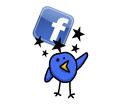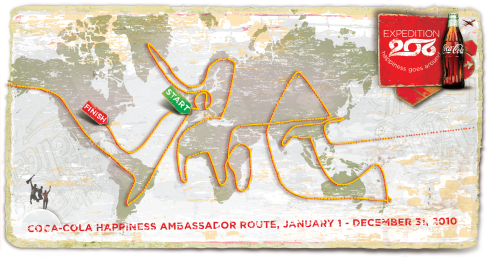You are currently browsing the monthly archive for December 2009.
Monthly Archive
A Bloggers Final Words
December 29, 2009 in Social Media | Tags: Bloggers, Blogging, Blogs, Wordpress | Leave a comment
 This blogging experience has been interesting and truly experiential. I have shared what I have found to be the most fascinating new media channels and brands, which I believe are doing a great job in reaching their consumers. As we approach 2010, let me tell you how I feel about blogging and what every new blogger should know.
This blogging experience has been interesting and truly experiential. I have shared what I have found to be the most fascinating new media channels and brands, which I believe are doing a great job in reaching their consumers. As we approach 2010, let me tell you how I feel about blogging and what every new blogger should know.
Blogging is a personal experience, it is the place to share your thoughts and opinions. It is also the place where your are most likely to have loyal readers. As such, whatever you decide to blog on, make sure that it is about something that you enjoy to be able to stay committed and true to those readers.  And when I say committed, I mean keep those posts coming, on a regular basis.
And when I say committed, I mean keep those posts coming, on a regular basis.
Blogs are all about content, content, content, and even more content. So make sure that you are writing about something you REALLY love. Poor content equates to no visibility. Write about anything and everything, as long as you have something to say. So choose your categories carefully and make sure that you have as many tags as possible per post. Because believe it or not, tags are a great way for your blog to be noticed.
Blogging platforms are free. That is if you are looking to keep your blog to the bear minimum. So some time doing a little research on which platform would best suit you and what you want to achieve out of it. If you are like me, a new comer, then DEFINITELY ask someone who isn’t. It is not much fun when you discover at a later stage that you can’t upload widgets or embed media from different sources!! So save yourself the frustration, and if your blog is there to stay, then I would advise that you invest a little to get that ‘my blog’ look.
Getting your blog noticed takes a lot of time. So don’t be discouraged when your statistics indicate small viewership. Definitely get your blog on your Facebook and Twitter pages, and any other social network you are a member of. As long as these networks will find what you are writing about is relevant, then viewers will come later rather than sooner.
When Sustainable Tourism Goes Social!
December 29, 2009 in Social Media | Tags: Buzz Building, Buzz Marketing, Development, Effective Marketing, Friend A Gorilla, Global Sustainable Tourism Alliance, GSTA, Intergrated Marketing Communications, Non-Profits, Social Marketing, Social Media, STAR, Sustainable Tourism, Uganda, USAID, Viral Campaigns | 1 comment
One of the things that I have come to learn over the years is how committed and smart people marketing for non-profit programs are. From communication strategists to social marketers, focus has been on overcoming the struggles faced with their external audiences and donor agencies. But times are changing. As the global economy encourages the use of social media, funded programs are promoting and communicating through social media platforms to encourage global participation.
The Global Sustainable Tourism Alliance (GSTA) was established in 2005 with 15 non-profit and for-profit organizations with significant experience in sustainable tourism development and funding by funding by the United States Agency for International Development (USAID) and the founding alliance members. With a holistic and systemic approach to sustainable tourism development, Uganda’s Sustainable Tourism in the Albertine Rift (STAR) launched the Friend-A-Gorilla program through its website and social networking sites. The innovative campaign has captured over 14,000 followers on Facebook and 1300 followers on Twitter, since its launch on September 26, 2009. The social buzz has also made it newsworthy with more than 500 news articles generated about the program worldwide creating the best international publicity Uganda has ever had.
In truth, you don’t have to be a big, powerful brand with a huge budget and global reach to incorporate these strategies. In fact, startups, small- and medium-size companies, associations, and non-profit groups are all benefiting from rethinking how they market their services.
Expedition 206- A Bottle Full of Happiness
December 26, 2009 in Social Media | Tags: Buzz Building, Buzz Marketing, Coca Cola, Expedition 206, Happiness Campaign, Social Media | Leave a comment
 Although Pepsi was the first to use Twitter, yet Coca-Cola has taken the tweets to the next level. With the launch of their ‘Happiness’ campaign, this summer (2009), Coke’s social media marketing strategy has focused on matching their marketing vehicles to their target consumers for better return on investment.
Although Pepsi was the first to use Twitter, yet Coca-Cola has taken the tweets to the next level. With the launch of their ‘Happiness’ campaign, this summer (2009), Coke’s social media marketing strategy has focused on matching their marketing vehicles to their target consumers for better return on investment.
The increase in the level of activity, interaction and engagement in brand related decision making has triggered new collaboration between the communications, public relations and marketing teams to think about the social and digital media space as a new venue for driving good public relations for the company, a new idea that takes full advantage of what social networks have to offer to expand the Coca-Cola brand. With a full year of social networking program up ahead, ‘Expedition 206’ is Coke’s new social initiative scheduled to play out on Twitter as well as on platforms like Facebook, YouTube and Flickr.
The innovative initiative places focus on fans driving the experience. From selecting three ‘happiness ambassadors’ to travel 206 countries during 2010 to fans following the journey online; Coke’s virtual global community and its visitors will vote on where the team goes, what they do and who they visit in each country.
Through tweets, blogging and uploading on YouTube of their adventures, the happiness ambassadors will tell the story of Coke around the world and the attributes of what the brand is about. The much anticipated program scheduled to begin in January 2010 has already generated enough buzzing for Coke, bringing forth even more enjoyable and pass along content to people.
Facebook or Twitter… It’s All User Generated Content
December 25, 2009 in Branding, Social Media | Tags: Branding, Buzz Building, Buzz Marketing, Coca Cola, Coke, Effective Marketing, Facebook, Public Awareness, Social Media, The Gap, Twitter, Viral Campaigns | Leave a comment
 User generated content allows brands to communicate in order to maintain relationships, attract and keep customers, strengthen brand value. When Gap realized it needed to revamp its branding and reconnect with their consumers, it chose Facebook. Why? Because it was the most effective way of being able to integrate its wide range of activities from advertising, public relations, promotions to gaining customer insight for product development. The Coca-Cola Company recently joined Twitter Fortune 100 clan with designated pages for each of its brands, the corporation has build its own virtual community to strengthen its branding image.
User generated content allows brands to communicate in order to maintain relationships, attract and keep customers, strengthen brand value. When Gap realized it needed to revamp its branding and reconnect with their consumers, it chose Facebook. Why? Because it was the most effective way of being able to integrate its wide range of activities from advertising, public relations, promotions to gaining customer insight for product development. The Coca-Cola Company recently joined Twitter Fortune 100 clan with designated pages for each of its brands, the corporation has build its own virtual community to strengthen its branding image.
When it comes to consumer generated content, everyone loves Facebook and Twitter. Apart from its easy navigation and reconnecting with people, Facebook provides the opportunity for brands to share any type of content from any media.
The Gap Facebook Page allows its fans to develop their own Gap ads, complete with personal information and photos from individual Facebook albums, learn about upcoming events and promotions, and even get linked to and participate in varied Gap contests, such as their ‘Born to Fit’ campaign contest, featured on Polyvore, to design an inspirational outfit with your own ‘Born to’ message.
Twitter has allowed Coke to gain information related to customer’s satisfaction, brand loyalty, desired future products/services and product attributes. The brand’s identification of different customer segments, based on culture and traditions that the virtual brand community members share has become a tool for strategically targeting marketing activities in real life environment, as well as predict future market trends and activities based on changes in behavior.
When we look at advertising strategies and the best ways to reach customers, we instantly visualize creatives that fit broadcast and print media. With personal data collection, Facebook is a powerful advertising platform. Through social media, Gap ditched TV and promoted its 1969 line (Born to Fit) mainly through Facebook. Coke not only utilized Twitter to discover what interests their targets, but have also succeeded in discovering the most active brand consumers, based on the millions who participated in the ‘happiness ambassador’ competition.
As such, brands succeed in conveying their messages through print, visual and audio techniques that facilitate consumer perceptions and interpretations of the brand and its products and services. At the end of the day, it is all about strategy, who is your target audience and what the brand is aiming to accomplish. Social networking is ultimately about communicating and maintaining relationships. And the best way to create this in order to strengthen your brand is by keeping your consumers updated, sharing images, inviting them to participate in events. In other words, displaying the human nature of your brand.




Recent Comments